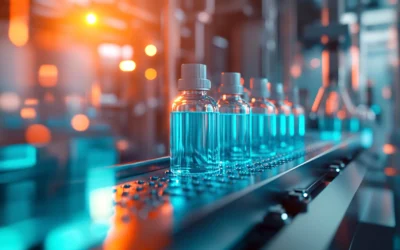Plastics for Injection Moulding: How to Choose the Right Material for Your Project
Material selection is one of the most critical decisions in the injection moulding process. The right plastic can lead to a longer-lasting, more cost-effective product, while the wrong choice could result in reduced performance or higher production costs. Understanding the different types of plastics available, along with their unique material properties, is key to making informed decisions in your manufacturing process.
Exploring the most common types of plastics, their unique properties, and their applications will help product designers and procurement managers navigate the complexities of plastic selection for injection moulding. With a clear understanding of which plastic best suits the product’s requirements and how expert choices impact both performance and sustainability, manufacturing professionals can make informed decisions that improve product quality, reduce production costs, and support environmentally responsible practices.
material propertiesWhy Choosing The Material Matters in Injection Moulding
The choice of plastic directly affects the product’s functionality, cost, and durability, determining whether it meets requirements and withstands wear and tear over time. For instance, certain plastic components are ideal for heat resistance, while others may be better suited for flexibility or impact strength.
There are several factors that procurement and sourcing managers must take into account:
- Heat Resistance:
Some applications require plastics that can withstand high temperatures without degrading. Plastics like polyetheretherketone (PEEK) and certain thermosetting polymers are perfect for such cases. - Mechanical Strength:
Products that endure heavy loads or stresses need materials with high tensile strength. Industrial plastic parts made from materials like ABS or polycarbonate offer exceptional durability. - Flexibility:
In cases where the product needs to bend or move without breaking, elastomers such as silicone and natural rubber are excellent choices. - Environmental Impact:
As sustainability becomes a priority, consumer plastics are shifting towards biodegradable or recycled options. These eco-friendly materials offer a greener alternative without compromising on quality.
Each of these material properties can drastically affect the lifespan, usability, and cost of the final product, making material choice a pivotal part of the injection moulding process.
3 Main Types of Plastics Used in Injection Moulding
The types of plastics used in injection moulding can be broadly classified into three categories: thermoplastics, thermosetting polymers, and elastomers. Each group has its unique characteristics, making them suitable for different types of products and applications.
1. Thermoplastics
Thermoplastics are highly versatile plastics that can be repeatedly melted and reshaped. This characteristic not only makes them recyclable but also allows for their use in a wide range of applications. Thermoplastics are especially popular in high-volume production because they can be melted, moulded, and remoulded without significant degradation in quality.
Examples:
- Polyethylene (PE):
Used widely in packaging, from plastic bags to bottles, thanks to its flexibility and cost-effectiveness. - Polypropylene (PP):
Known for its toughness and chemical resistance, polypropylene is used in automotive parts, textiles, and consumer goods. - Polystyrene (PS):
Often found in packaging materials and disposable items such as cutlery and cups, polystyrene is prized for its light weight and cost-efficiency. - Acrylonitrile Butadiene Styrene (ABS):
ABS is a robust material used in automotive components, electronics, and durable consumer products. - Polyvinyl Chloride (PVC):
Used extensively in construction for pipes and profiles, PVC is valued for its rigidity and resistance to environmental exposure.
Applications:
Thermoplastics are ideal for applications such as automotive parts, packaging, household products, and electronics.
Key Properties:
Thermoplastics offer durability, flexibility, and the ability to be recycled, making them highly sustainable in modern manufacturing processes.
2. Thermosetting Polymers
Thermosetting polymers differ from thermoplastics in that they cannot be remelted after curing. Once set, they form a rigid and durable structure that makes them perfect for high-heat and high-stress applications. They are especially valued for temperature resistance, which enables them to withstand extreme conditions without losing their structural integrity.
Examples:
- Epoxy Resin:
Frequently used in adhesives, coatings, and electronic encapsulation due to its excellent bonding properties and chemical resistance. - Phenolic Resin:
Commonly used in electrical insulation and as a binding agent in products requiring heat resistance. - Melamine Formaldehyde:
Best known for its use in durable kitchenware and laminate surfaces, melamine formaldehyde is valued for its heat resistance and durability.
Applications:
Thermosetting polymers are commonly used in electrical components, high-heat applications, adhesives, and coatings where durability is essential.
Key Properties:
They offer unmatched heat resistance and rigidity, making them suitable for long-lasting, high-performance products that can endure harsh conditions.
3. Elastomers
Elastomers are rubber-like materials that are known for their flexibility and elasticity. These plastics can be stretched, compressed, and manipulated, yet still return to their original shape, making them perfect for products requiring a high degree of flexibility.
Examples:
- Silicone:
Widely used in medical devices, cookware, and automotive applications, silicone offers excellent heat resistance and flexibility. - Natural Rubber:
Found in tyres, seals, and gaskets, natural rubber provides superior flexibility and shock absorption. - Polyurethane:
Used in a variety of applications, from insulation panels to foam seating, polyurethane is known for its versatility and durability.
Applications:
Elastomers are typically used in seals, gaskets, tyres, and flexible components where flexibility and durability are critical.
Key Properties:
High flexibility, resistance to wear, and excellent durability make elastomers indispensable in products requiring flexibility and long life.
How to Select the Right Plastic for Every Project
Choosing the right plastic product for a project requires procurement and sourcing managers to carefully consider several factors:
- Mechanical Properties:
Does the product need to withstand significant mechanical stress or retain flexibility? Stronger materials like ABS or thermosetting polymers might be required for mechanical strength, while elastomers are best for products needing flexibility. - Cost:
The cost of materials will inevitably impact the overall project. Thermoplastics tend to be more affordable for high-volume production, while advanced plastics like PEEK are costlier but offer superior performance. - Environmental Impact:
As manufacturers seek to reduce their environmental footprint, selecting recyclable or biodegradable plastics is becoming more common. Thermoplastics are generally easier to recycle, making them a preferred choice for eco-friendly products. - End-Use Application:
The demands of the product’s intended use must guide material selection. Products exposed to high heat will require plastics with strong heat resistance, while impact-resistant materials are crucial for items that will experience mechanical stress.
The goal is to find the perfect balance between quality and cost, ensuring that the material meets the product’s performance requirements without exceeding budget limitations.
Innovations in Plastics for Injection Moulding
Since technology has advanced and consumer demands shifted, the plastics industry is constantly evolving to address new challenges. Innovations in materials are driving changes in both sustainability and performance, offering manufacturers more options to meet the demands of modern production.
Sustainable Materials:
In recent years, the focus on sustainability has driven the development of biodegradable and recycled plastics. These eco-friendly options offer a way to reduce the environmental impact of manufacturing without sacrificing the quality or performance of the product. For example, bioplastics derived from renewable sources such as corn starch or sugarcane are becoming popular in packaging and consumer goods.
Advanced Plastics:
High-performance plastic resins such as Polyetheretherketone (PEEK) are revolutionising industries like aerospace, medical devices, and automotive manufacturing. PEEK is incredibly strong, heat-resistant, and chemically inert, making it ideal for critical applications where material failure is not an option. These advanced materials are pushing the boundaries of what plastics can achieve, offering greater durability and performance in extreme conditions.
Selecting the right plastic for any injection moulding project is a critical decision that impacts your product’s quality, durability, and cost. Whether the choice is thermoplastics for their recyclability, thermosetting polymers for their heat resistance, or elastomers for their flexibility, understanding the properties and applications of each plastic type ensures a better end product.
Contact us for expert advice and ensure your product is manufactured with the best possible materials.
Let us guide you to make the best choice for a cost-effective, durable, and high-quality outcome.
Explore more related content
Challenges in Injection Moulding and How to Overcome Them
Challenges in Injection Moulding and How to Overcome Them: Expert Tips for decision makers Injection moulding is an...
PCB manufacturing and molding challenges
PCB manufacturing and molding challenges: Increasing Shipping Costs and Multiplying ProblemHow can businesses protect...





